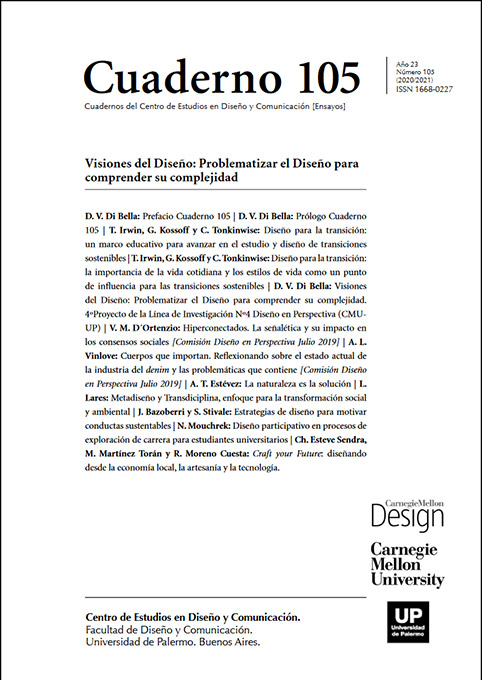Estrategias de diseño para motivar conductas sustentables
Abstract
This work enters into the contributions of sustainable design beyond the production stage, focusing on the period of use. It addresses the problem of waste from the perspective of design strategies, which allows evaluating the user’s reactions to different stimuli, which can be identified as sustainable behaviors. It constitutes a line of research in design with the intention of influencing user behavior. It considers interdisciplinary articulations and connections, which include the socio-economic and psychological areas, in their approach to the problem under study. The aspects to investigate refer to how the design can strengthen sustainable behaviors in users? And what design strategy model with intention is valid in the local context? To understand how the products and services used daily can be designed, placed in their context of use, and would enable the designer to review their design process, evaluate tools and strategies to facilitate the development of more sustainable behaviors and behaviors. The impact of this type of research, regardless of improving the practice of design for behavior change, transcends the academic scenario, since it makes it possible to address social and environmental problems, gathering knowledge of different disciplines and establishing parallels that allow the transposition of concepts.
References
Barreto, I. y Neve Chavez, S. (2014). Eficacia de tácticas de influencia en la intención de conducta pro-ambiental. Revista Latinoamericana de Psicología 2014. Fundación Universitaria Konrad Lorenz, Bogotá, Colombia. Disponible en: www.Elsevier.Es/rip Nro 46 (2) pp. 111-116. Consulta 9/04/2018
Bhamra, T.; Lilley, D. y Tang, T. (2008). Sustainable use: Changing consumer Behaviour through Product Design, in Changing the Change: Design Visions, Proposals and Tools, Turin, Proceeding.
Bazoberri, J. y Canetti, R. (2018). Articulación de herramientas analíticas en el diseño de eco-productos.
González Cano, M.; González, F. A.; Lama, J. R. y Gutiérrez Pérez, J. R. (2009). Ingeniería Kansei para un diseño de productos centrado en los usuarios. Técnica Industrial 280, 69-74.
Corral Verdugo, V. y Pinheiro, J. (2004). Aproximaciones al estudio de la conducta sustentable en Medio ambiente y comportamiento humano, 5 (1 y 2), 1-26. ISSN 1576-6462.
Jegou, F. y Manzini, E. (2008). Collaborative Services: Social innovations and design for sustentainability. Milan, Ed. Poli.design Consorcio del Politécnico de Milán.
Lidman, K. y Reström, S. (2011). How to design for sustainable behaviour? Göteborg, Sweden: Chalmers University of Technology.
Lockton, D. (2013). Design with intent: A design Pattern Toolkit for environmental & social behaviour change. Dissertation. UK Brunel University London.
Meroni, A. (2008). Strategic design: Where are we now? Reflection around the foundations of a recent discipline. StrategicDesignResearchJournal1, 31-38.
Olaya Rodriguez, A. (2018). Make them behave sustainably. Disponible en: www.makethembehave.com. ISBN 978-1984221070. 188 pp. Create Space. Amazon.
Retamozo, E. y Clinckspoor, G. (2019). Tipificación de las conductas ambientales para diseño con intención sustentable. Argentina: Semana Nacional de la ciencia FAUD investiga. ISSN -2019-0923.
Los autores/as que publiquen en esta revista ceden los derechos de autor y de publicación a "Cuadernos del Centro de Estudios de Diseño y Comunicación", Aceptando el registro de su trabajo bajo una licencia de atribución de Creative Commons, que permite a terceros utilizar lo publicado siempre que de el crédito pertinente a los autores y a esta revista.


